Abstract
Gallium Arsenide (GaAs) Schottky technology stands out for its superior performance in terms of conversion loss for terahertz mixers at room temperatures, which establishes it as a dominant solution in receivers for high-data-rate wireless communications. However, Indium Gallium Arsenide (InGaAs) Schottky mixers offer a notable advantage in terms of reduced power requirements due to their lower barrier height, enabling optical pumping with the incorporation of photodiodes acting as photonic local oscillators (LOs). In this study, we present the first comparative analysis of GaAs and InGaAs diode technologies under both electrical and optical pumping, which are also being compared for the first time, particularly in the context of a wireless communication system, transmitting up to 80 Gbps at 0.3 THz using 16-quadrature amplitude modulation (QAM). The terahertz transmitter and the optical receiver’s LO are based on modified uni-traveling-carrier photodiodes (MUTC-PDs) driven by free-running lasers. The investigation covers a total of two mixers, including narrow-band GaAs and InGaAs. The results reveal that, despite InGaAs mixers exhibiting higher conversion loss, the bit error rate (BER) can be as low as that with GaAs. This is attributed to the purity of optically generated LO signals in the receiver. This work positions InGaAs Schottky technology as a compelling candidate for terahertz reception in the context of optical wireless communication systems.
1. Introduction
The growing need for higher data rates in wireless communications has driven significant interest in the terahertz (THz) spectrum, emphasizing in the development of efficient and reliable devices capable of operating at these frequencies. The THz range, which spans 100 GHz to 10 THz, has immense potential to enable unprecedented wireless data transmission speeds, pushing the boundaries of modern telecommunications [,]. Research on the technology operating in this range is crucial to achieve high-data-rate wireless communication systems capable of delivering multi-gigabit-per-second data transfer rates [,]. In this regard, the IEEE standard 802.15.3d-2017 has emerged as the first effort to standardize wireless terahertz networks in the 252–325 GHz band []. This frequency range has been chosen due to the presence of atmospheric windows, which are regions in the electromagnetic spectrum where the Earth’s atmosphere exhibits low absorption and attenuation of THz signals [,]. Operating within these atmospheric windows allows wireless systems to use the available spectrum effectively, enabling long-distance communications in this domain.
Wireless high-speed communications have already been achieved at 300 GHz employing different receiver architectures. In the works [,], data rates of 10 Gbps and 3.2 Gbps were successfully transmitted over distances of 58 m and 1 m, respectively, utilizing photoconductors. Schottky Barrier Diodes (SBDs) have been widely used in fast communications, and two examples of their use can be found in [,], where the transmission of 59 Gbps over 1.5 m at 328 GHz and 115 Gbps over 110 m at 320 GHz were reported. Furthermore, the studies presented in [,] demonstrate the feasibility of high-data-rate wireless links operating at 300 GHz over distances of a few meters. Specifically, these works report successful data transmissions of 50 Gbps and 260 Gbps, respectively, utilizing sub-harmonic mixers.
The improvement of receivers at these frequencies becomes imperative to achieve higher data rates at longer distances. However, harnessing this potential requires overcoming technical challenges associated with THz devices. In this context, mixers play an important role in the reception of THz signals, particularly in heterodyne schemes, where a high radio frequency (RF) signal is mixed with a local oscillator (LO) to generate a lower intermediate frequency (IF) signal []. In this specific application, diode-based mixers appear to be an excellent solution to efficiently operate as receivers in this frequency range due to their excellent capabilities in conversion loss (CL) and power consumption []. Among the most promising candidates for THz mixers, GaN-based mixers exhibit outstanding power handling capabilities compared to other semiconductor technologies, making them a strong candidate for lower-frequency applications where high input power is not a limitation [,]; however, their suitability for high-speed applications is limited, as they typically exhibit higher conversion loss than, for example, GaAs [,]. In contrast, GaAs-diode-based mixers have been extensively studied and used for high-frequency and high-speed applications [,,]. GaAs diodes are well suited for these purposes due to their exceptional electron mobility and high electron saturation velocity []. These characteristics enable GaAs mixers to achieve low conversion loss and noise figure (NF) in high-frequency bands [,,]. Alternatively, InGaAs diodes appeared as a solution offering several distinct advantages, particularly in terms of lower power requirements. InGaAs mixers have already demonstrated local oscillator power requirements five to ten times lower than GaAs mixers, enabling efficient energy utilization leading to reduced power consumption without significantly compromising performance [].
The successful operation of THz mixers is also dependent on the availability of reliable and efficient LO sources. Advances in fabrication technology and precision machining techniques have led to significant improvements in the output power of mm-wave and sub-mm-wave sources. Electronic sources based on multiplication chains currently hold a dominant position in the field due to the technology’s longevity, reliability, and maturity. As an example, GaAs-diode-based sources have shown outstanding performances at frequencies beyond 1 THz []. However, their main disadvantage is the decrease in power handling and output power as the frequency increases. The development of InGaAs mixers opened up new possibilities in the available LO sources, allowing integration with optical down-conversion techniques [,]. In this approach, two lasers at different frequencies are combined in a photodiode to generate a beat signal, which serves as the LO to pump the mixer []. This method provides a wide bandwidth and tunability over the LO range, enabling the use of a single source to cover several bands. In contrast, electrically generated LOs follow an up-conversion process. This means that the LO frequency is increased from DC to higher frequencies, typically by a multiplication factor denoted as ‘N’. As a consequence of this up-conversion, the phase noise of the LO signal suffers a notable increase in its power spectral density by a factor of 20·log(N) dBc/Hz. However, when the LO is optically generated, it undergoes a down-conversion process from high to low frequencies. In the case of optical heterodyne mixing to generate THz signals, the UTC is responsible for converting the optical beat frequency into a lower-frequency electrical signal. In this scenario and applying phase locking to the lasers, optical pumping potentially offers a lower noise profile and higher purity of LO signals compared to electrical approaches [].
In this paper, we provide a comparative analysis of GaAs and InGaAs mixers, focusing on both optical and electrical pumping techniques. GaAs diodes are known for their superior conversion efficiencies, while InGaAs diodes require lower input power, making them particularly compatible with optical pumping methods. Our objective is to explore these key differences and assess their impact on performance metrics such as the BER and EVM. By examining the advantages and limitations of both technologies, we assess their suitability for integration into future high-speed photonic-based THz wireless communication systems. This work is novel, as it presents a direct comparison of GaAs and InGaAs mixers under different LO pumping conditions, which is an analysis that has not been thoroughly explored in previous research.
The article is structured as follows: Section 2 presents the THz wireless communication setup, providing a detailed description of both the transmitter and receiver sides. In the receiver, we discuss two different pumping techniques, electrical and optical, discussing their implementation in the system. Additionally, we introduce the mixers under study and describe the DSP technique used throughout the experiments. Section 3 then presents the experimental results, evaluating the performance of the mixers as receivers under both electrical and optical pumping. A comparative analysis is done in terms the BER and EVM. We then examine the effects of using a non-optimal phase noise cancellation DSP, highlighting its influence on system performance. Finally, the conversion loss improvement of InGaAs-based mixers is briefly discussed.
2. Description of the THz Wireless Communication Setup
2.1. THz Transmission Setup
A schematic overview of the wireless THz link architecture is given in Figure 1a. To modulate the baseband In-phase and Quadrature (I/Q) signal in 16-quadrature amplitude modulation (QAM) format, it is first digitally up-converted to an IF using the sample rate (Rs/2 + 1.5 GHz). The analog signal at the output of the Arbitrary Waveform Generator is used as data in the Mach–Zehnder modulator (MZM), which is responsible for the modulation of the optical carrier. The system’s structure involves the utilization of two lasers operating at 193 and 193.3 THz, respectively. Laser two is intensity-modulated using the MZM, and the resulting modulated signal is combined with the optical THz output from laser one through a 50:50 combiner. To ensure appropriate power, an Erbium Doped Fiber Amplifier (EDFA) is placed after the combiner, amplifying the signal before driving it to the high-power modified uni-traveling-carrier photodiode, MUTC-PD [], which converts from the optical to the electrical domain generating the 300 GHz signal. To transmit the output of the MUTC-PD across 1.5 m of free space, this is connected to a WR3.4 probe and subsequently radiated by a WR3.4 horn antenna with 24 dBi gain. To minimize the impact of free space losses between the transmitter and receiver, two Teflon lenses are placed and carefully aligned.

Figure 1.
THz transmission and reception architecture. (a) shows photonic transmitter based on optical heterodyne mixing in a probed modified uni-traveling-carrier photodiode (MUTC) to generate THz signals, where data are provided by modulating one of the laser arms. After transmission in the wireless channel, the signal is down-converted to IF using a sub-harmonic mixer (SMH) pumped by two different approaches. The first case is similar to the TX, using the beating of two lasers, and the second case uses electrical pumping. (b) shows a picture of the THz transmitter consisting of the probed MUTC connected to a horn antenna pointing to the receiver. (c) shows a picture of the receiver; here, the mixer is connected to a probed MUTC, which generates the LO signal to pump the mixer. (d) shows a picture of the electrically pumped receiver, consisting of an AMC connected to the mixer.
2.2. THz Receiver Setup
The receiver configuration, as illustrated in Figure 1, comprises a WR3.4 antenna connected to a selection of mixers, which is the focal point of this investigation. Unlike Schottky Barrier Diodes (SBDs) [,], the high performance of the mixers used in this study avoids the use of any RF amplifier, considerably reducing the power consumption and the receiver noise figure. The down-converted IF signal is connected to a Low-Noise Amplifier (LNA), and the output goes to an oscilloscope (Agilent DSO-X 93304Q) to measure and capture the received signal.
This study explores two distinct approaches of LO, optical and electrical pumping techniques, which are defined as follows:
- Optical pumping consists of a similar approach as the transmitter, as is seen in Figure 1c). The optical signal from the two different lasers is coupled to a 50:50 coupler. The output is amplified using an EDFA which is again connected to a probed MUTC-PD which acts as an LO source to pump the mixers. This is possible due to the high output power of the diodes provided by the UDE [,] and the low LO power requirements of the InGaAs mixers. The photodiodes used in this study were not able to achieve the required output power to pump the GaAs mixer. However, recent advancements in photodiode technology have demonstrated the ability to generate a few milliwatts of output power at higher frequencies [,].
- The second approach is to use multiplication chains based on GaAs diodes; see Figure 1d). This technique has been widely used in extenders, sources, and active multiplier chains (AMCs) to reach frequencies above 500 GHz []. The AMC used in this study is provided by ACST. Its typical 10 dBm of output power is enough to be used as an LO source in both the GaAs and InGaAs mixers. Although, to be used with InGaAs diodes, a waveguide variable attenuator is placed between the mixer’s LO port and the AMC output to reduce the power to levels below the damage threshold.
The different characteristics in terms of operational frequency, IF bandwidth, conversion loss, and local oscillator power requirements are presented in Table 1. These key parameters are given for the two different mixers that will be compared in this study: narrow band mixers employing GaAs and InGaAs diodes.

Table 1.
Main characteristics of the mixers under study, where diode technology, frequency, bandwidth, conversion loss, and LO power requirements are compared.
In terms of the frequency range, both narrow band mixers using GaAs and InGaAs diodes cover part of the WR3.4 range spanning from 270 to 320 GHz. Regarding the IF bandwidth, both mixers employ high-quality SMA connectors, enabling IF frequencies beyond 25 GHz. Focusing on the conversion loss, which quantifies the power loss during the down-conversion process, we observe variations among the different mixers. The narrow-band mixers using GaAs diodes show double-side-band (DSB) conversion loss of 6 dB, and those mixers with InGaAs show values of 13 dB. Generally, lower conversion losses are preferred to ensure higher efficiency in signal processing. Lastly, we consider the LO power requirements for each mixer type. It is well known that GaAs-based mixers typically have relatively higher LO power demands, from 1 to 3 mW for narrow-band and 4 to 10 mW for full-band mixers. In contrast, InGaAs-based mixers show significantly lower LO power requirements, needing 0.1 to 0.5 mW for this particular design. A picture of the mixers under study is shown in Figure 2. Independently of the diode technology, both mixers have the same block.
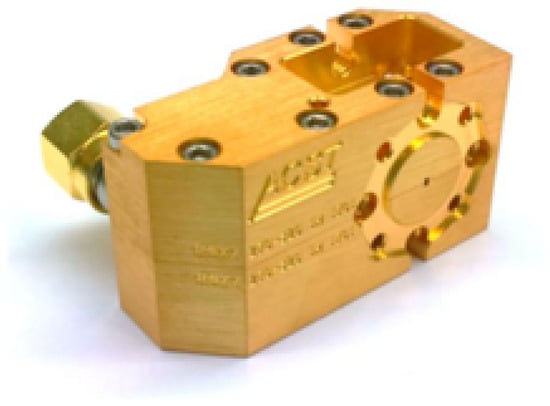
Figure 2.
The 300 GHz sub-harmonic mixer mechanical block used in this study. The mixer presents a WR 6 and a WR 3.4 rectangular waveguide for the LO and RF ports, respectively. The narrow-band mixer employs a high-performance SMA female connector enabling IF frequencies above to 25 GHz.
The NF of the GaAs- and InGaAs-based Schottky diode mixers as a function of LO power is depicted in Figure 3. These results were obtained under electrical pumping conditions.

Figure 3.
Measured noise figure over the LO power requirements of the two narrow-band sub-harmonic mixers. In (a), the measurements taken with the GaAs-diode-based mixer are shown. In (b), measurements obtained with the InGaAs mixer are shown.
As seen in Figure 3a, the GaAs-based mixer exhibited superior performance, reaching a minimum NF of approximately 6 dB. The noise figure decreased sharply as the LO power increased, stabilizing at 1.5 mW, where it reached a plateau. Beyond this power level, the NF remained constant even at LO power levels, exceeding 3 mW. However, at LO powers below 1 mW, the NF deteriorated significantly, indicating that the mixer operates inefficiently in this regime and would not be suitable for practical applications at such low LO drive levels.
In contrast, Figure 3b illustrates the performance of the InGaAs-based mixer, which achieved acceptable NF values with substantially lower LO power. The NF improved rapidly as the LO power increased from 0.05 mW to 0.15 mW, where it reached a local minimum and stabilized. Unlike the GaAs mixer however, the InGaAs device exhibited a degradation in NF when the LO power continued to increase. Beyond 0.4 mW, the NF rose noticeably, indicating a power-dependent degradation mechanism. This happens due to exceeding the opimal operational point of the diodes, resulting in noise figure degradation.
These results highlight that the GaAs mixer demonstrates lower NF at optimal LO drive levels and requires significantly higher LO power to achieve this performance. The InGaAs mixer, on the other hand, offers acceptable NF with minimal LO drive but suffers from performance degradation at higher LO powers.
2.3. DSP Algorithm
To recover the transmitted data, a Digital Signal Processing (DSP) routine was used to process the IF signal and retrieve the data. The receiver’s DSP steps employed in the experiments are illustrated in Figure 4. First, the signal’s clock is recovered by performing a cross-correlation with the transmitter waveform. This is followed by a down-conversion, inverse raised-cosine filtering, and resampling to achieve two samples per symbol. The equalization comprises a set of three blind equalizers: a (1) radius-directed equalizer (RDE), (2) carrier phase estimation (CPE), and (3) least-mean-square decision-directed equalizer (LMS-DDE). The carrier phase estimation is particularly critical, having to compensate for the phase noise contribution arising from the 80 kHz linewidth free-running lasers. While this contribution is confined to the transmitter in electrically pumped receiver cases, in the optically pumped scenarios, it is also present in the optically generated LO. To address this, the algorithm proposed in [] is used, which can compensate for laser linewidths in the order of several MHz. In the last section of the article, the performances using a non-optimized algorithm for free-running lasers will be shown, highlighting the importance of an adequate DSP.

Figure 4.
DSP block diagram used in reception. RDE is the radius-directed equalizer, CPE is the carrier phase estimation, and LMS-DDE is the least-mean-square decision-directed equalizer.
3. Results and Discussion
In this section, the system is evaluated in terms of the BER and EVM. The BER corresponds to the proportion of incorrectly received bits compared to the total number of transmitted bits []. The EVM quantifies the deviation of a received signal from its ideal reference in the IQ plane, which is expressed as the root-mean-square (RMS) error normalized to the ideal signal power []. A more detailed theoretical background on the BER and EVM can be found in [,].
3.1. Constellation Diagrams
In this section, we present retrieved constellation diagrams using the two mixers under electrical and optical pumping conditions. Figure 5 shows the resulting diagram for 40 and 80 Gbps of received data using electrical pumping.
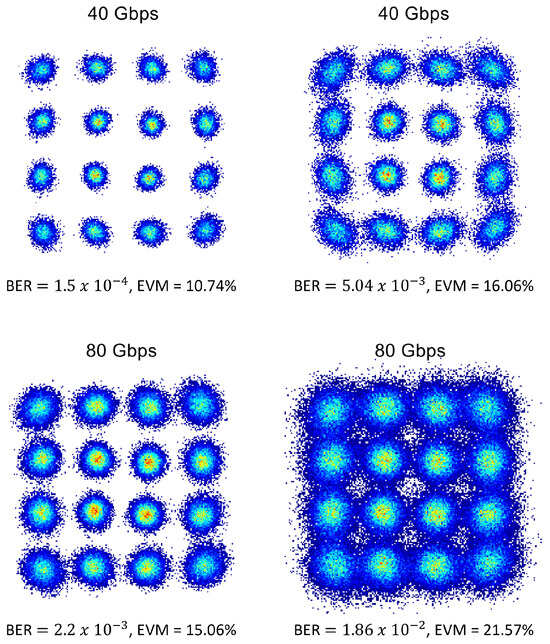
Figure 5.
Constellation diagram of the 40 and 80 Gbps transmission links using two different mixers electrically pumped. Left and right results correspond to the GaAs and InGaAs mixer, respectively.
We observe that the GaAs-based mixer exhibited superior performance compared to the InGaAs-based mizer. The GaAs mixer demonstrated tighter and better-defined signal clusters indicative of reduced signal distortion and a better EVM. The BERs obtained in this case were and for the 40 and 80 Gbps of transmission, respectively.
In contrast, the InGaAs mixer, while efficient, showed slightly wider and worse defined signal clusters, reflecting relatively higher levels of signal distortion and higher EVM values and showing a BER of and at 40 and 80 Gbps, respectively. Therefore, the GaAs mixer was able to recover the transmitted data, showing a BER below the hard-decision forward error correction (HD-FEC) limit, while the BER obtained with the InGaAs mixer stayed close to the soft-decision FEC (SD-FEC) limit. An interesting observation is that the remanent phase noise after the DSP routine was more pronounced in the InGaAs-based mixer case. This shows that the phase noise cancellation algorithm is indeed sensitive to the input signal quality, which is impaired when using the InGaAs-based mixer due to the higher conversion loss and overpumping conditions, as will be discussed later.
Notably, the results described above strongly corroborate the performance outcomes described in Table 1, which outlines the superior capabilities of GaAs mixers over InGaAs mixers under electrical pumping. This was already demonstrated in [], where the first comparison between InGaAs and GaAs in terms of the CL was reported.
In Figure 6, the captured IF spectrum of the received signal is shown. A clear representation of the carrier is observed at 25 GHz, being the 20 GHz of data bandwidth on either side, ensuring that the signal is within the available 33 GHz bandwidth of the oscilloscope.
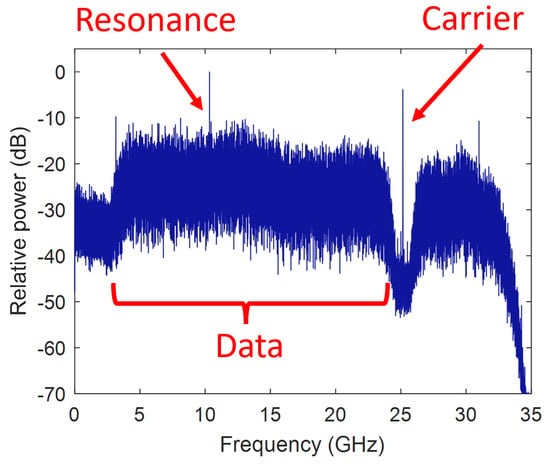
Figure 6.
IF spectrum using electrical pumping; 20 GHz of data bandwidth captured, with the carrier centered at 25 GHz. An unwanted harmonic is noticeable at 10.2 GHz coming from the AMC.
In addition to the carrier and data signals, the presence of an unwanted resonance is noticeable at 10.2 GHz. This effect arises due to non-linearities within the LO source, which can introduce unwanted frequencies resulting from interactions in the multiplication stages and potentially leading to undesired signal distortion and degradation in the received data. The presence of this resonance warrants careful consideration, as it can significantly impact the overall performance of the system.
Unlike electrical pumping, the optically pumped mixer exhibited minimal to no presence of unwanted resonances in the received spectrum of the data, as seen in Figure 7. This crucial advantage not only enhances signal fidelity but also contributes to a substantial reduction in signal distortion and intermodulation effects.
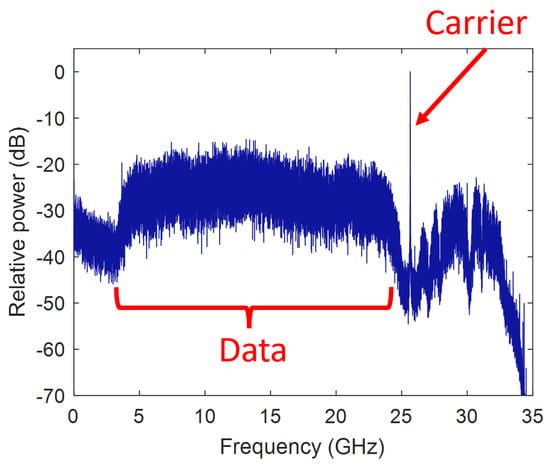
Figure 7.
IF spectrum using optical pumping; 20 GHz of data bandwidth captured, with the carrier centered at 25 GHz. No unwanted harmonics appeared.
In the IF spectrum shown in Figure 7, the data transmission rate remained at 80 Gbps, and the bandwidth was again 20 GHz with a 1.5 GHz separation from the carrier.
Figure 8 illustrates the constellation diagrams obtained using an InGaAs narrow-band mixer, where well-defined clusters of constellation points can be observed. The measured BER reached a value of and at data rates of 40 and 80 Gbps, respectively. This indicates that a BER below the HD-FEC limit can be also achieved with the InGaAs-based mixer as a direct consequence of using optical pumping. It is important to note that the integration of optical pumping with GaAs mixers was not possible because of their high-demand LO power requirements compared to InGaAs mixers.
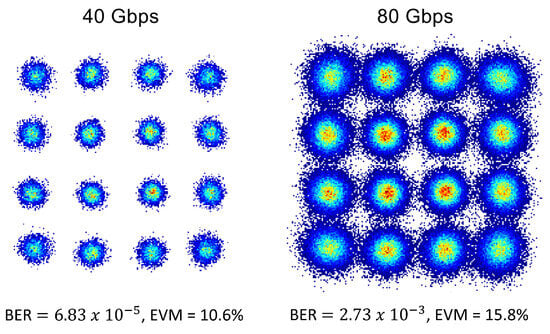
Figure 8.
Constellation diagrams of the 40 and 80 Gbps transmission link using optical LO.
3.2. Bit Error Rate and Error Vector Magnitude
In this section, the performance obtained for the two different mixers is discussed. In Figure 9a,b we present a comparison of the BER and EVM performance across a spectrum of mixers operating at data rates from 10 to 80 Gbps.
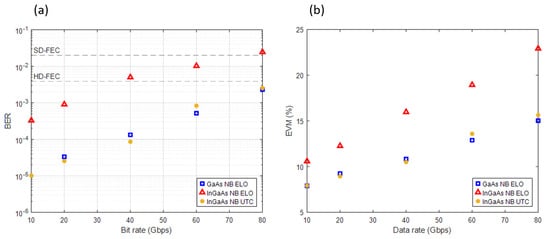
Figure 9.
BER and EVM comparison of different GaAs and InGaAs sub-harmonic mixers. Narrow-band (NB) results under electrical (ELO) and optical (UTC) pumping. (a) BER evaluation of the THz link using different sub-harmonic mixers and pumping approaches. (b) EVM assessment of the THz link using different sub-harmonic mixers and pumping methods.
Regarding the GaAs mixer, Figure 9a,b show how the electrically pumped mixers maintained exceptionally low BER and EVM levels across the data rate while remaining below the HD-FEC threshold. Similarly, the InGaAs narrow-band optically pumped mixer demonstrated noteworthy performance and operated within the HD-FEC limits as well. According to Table 1, the InGaAs narrow-band mixers should perform worse than their GaAs counterparts due to the higher conversion loss. Nevertheless, the optically generated signals demonstrated a higher purity than electrical ones. Consequently, the purity of the LO signal compensated for the anticipated performance gap, leading to equivalent final results.
In contrast, the InGaAs narrow-band mixer, when subjected to electrical pumping, exhibited the least favorable BER and EVM outcomes and stayed close to the SD-FEC threshold. This issue is a result of the higher conversion loss, but it is also attributed to the LO signal being too high. The AMC employed in the electrically pumped study provided an average output power of 10 mW. To regulate the power level reaching the InGaAs mixer, a 10 dB attenuator was placed before it, reducing the signal to approximately 1 mW at the mixer’s input. However, as observed in Figure 3, the NF increased with the input power, indicating that the applied attenuation was not enough to maintain the mixer within its optimal operating range. Consequently, the Schottky diodes experienced overpumping effects, leading to unwanted non-linear effects that degraded performance [].
An important figure of merit to compare the different measurements is the signal-to-noise ratio (SNR) achieved in each case. To extract this value, we can use the following theoretical expression for 16-QAM modulation []:
where is the inverse error function. With the SNR, we can then calculate the penalty in dB comparing the different mixers. This is depicted in Figure 10.
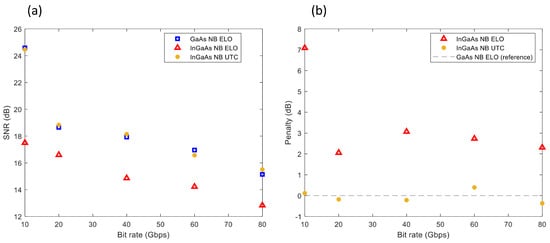
Figure 10.
Calculated SNR (a) and penalty (b) for the different mixers, taking as a reference the GaAs device with electrical pumping. The SNR is calculated from the BER measurements with Equation (1).
Since the obtained BER was very similar for the electrically pumped GaAs and optically pumped InGaAs mixers, the calculated SNR was consistent, with maximum and minimum values of approximately 24.5 dB and 15.5 dB for 10 Gbps and 80 Gbps, respectively. In contrast, the electrically pumped InGaAs mixer exhibited a penalty of approximately 2–3 dB in most cases, with the exception of 7 dB for 10 Gbps. It is important to note that the extracted SNR does not take into account non-linear effects or other impairments that contribute to degrading the BER. Therefore, this figure of merit serves as a simple tool to compare the mixers from a system point of view.
In summary, the key finding is that GaAs mixers have traditionally been used with electrical pumping due to their high power requirements, making them the preferred option for applications such as communications. Our results demonstrate that an InGaAs mixer under optical pumping, despite exhibiting higher conversion losses, can achieve performance comparable to electrically pumped GaAs mixers. This breakthrough paves the way for future advancements and novel designs in THz receivers, offering new possibilities for improved integration and efficiency in next-generation wireless communication systems.
3.3. The Effect of Using Non-Optimal Carrier Phase Estimation
The results presented in this study rely on a DSP routine utilizing a feedforward phase noise estimation algorithm []. This type of algorithm is particularly effective for the cancellation of free-running laser phase noise, which is the case in the experiment. To better assess its capability in the context of electrically and optically pumped scenarios, we alternatively applied different DSP routines. In this instance, the algorithm was replaced by a classic phase-lock-loop (PLL)-based scheme described in [].
In Figure 11a, the BER obtained for the modified DSP is shown. The BER was consistently close to or above the SD-FEC limit in every case. The highest BER values were observed at the lowest bit rates, with a slight improvement as the bit rate increased. This behavior is well explained by non-optimal phase noise cancellation. As the rate increases, the relevance of phase noise, linked to the laser linewidth, diminishes as a result of the faster signal.

Figure 11.
Results with PLL-based carrier phase recovery DSP: (a) BER and (b) 40 Gbps constellations of narrow-band InGaAs mixer with electrical pumping (left) and optical pumping (right).
The comparison between electrically and optically pumped scenarios reveals that the electrical pumping achieved superior performance, contrasting the results obtained with the feedforward-based algorithm. This reaffirms the non-optimal carrier phase estimation, where the electrical LO introduces less phase noise than the optical LO. In Figure 11b, the constellations derived when using the narrow-band InGaAs mixer under electrical and optical pumping are depicted. It is visually evident how the constellation in the optically pumped case exhibits greater phase noise.
These results highlight the importance of the phase noise estimation algorithm. The electrical pumping scenario is superior only when the algorithm is not able to correctly estimate the carrier phase; this happens because phase-locked lasers were not used. If phase-locked lasers were employed, the phase noise would have been lower, resulting in significantly improved outcomes even without the use of the DSP. It has been demonstrated that the phase noise can be adequately canceled, and therefore, an optically pumped receiver can achieve equal or better results than with electrical pumping. This is especially remarkable considering that the InGaAs narrow-band mixer performed comparably to the GaAs mixers despite the detriment in conversion loss.
3.4. Improving the Conversion Loss of InGaAs Diodes
As discussed, a main limitation of the InGaAs mixer used in this study is the high conversion loss compared to the GaAs mixer. The InGaAs diodes used here were not optimized for mixing purposes, and the epilayer doping level was moderately low. However, if the doping level is increased, the conversion loss can be improved, reducing the performance gap between InGaAs and GaAs diodes. This was verified through simulations by considering the same mixer circuit and waveguide block while testing different diode configurations. The comparison of the conversion loss is depicted in Figure 12. It is observed that, by increasing doping, the conversion loss was reduced by 2 dB, resulting in a similar CL to those achieved with the GaAs mixer.
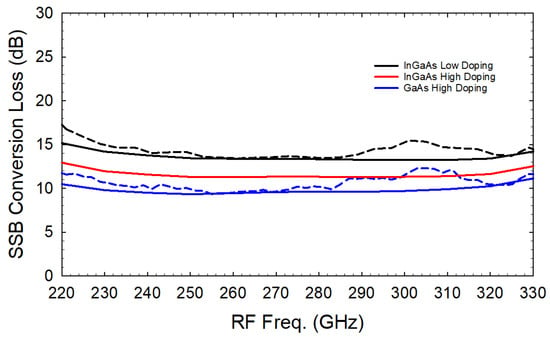
Figure 12.
Simulated conversion loss (straight line) of GaAs mixers using highly doped epitaxy versus InGaAs mixers using high- and low-doped epitaxies and experimental measured results (dotted line) of the high-doped GaAs and low-doped InGaAs. In the current study, we used the low-doped InGaAs and high-doped GaAs.
The simulations accurately predict the experimental results shown in Figure 12. As previously observed with high- and low-doped GaAs and InGaAs diodes, we are confident that the fabrication of highly doped InGaAs diodes will yield performance consistent with the simulations, experimentally reducing the performance gap between semiconductor technologies by 2 dB.
4. Conclusions
In this work, we compared two different mixers within the framework of wireless optical THz communications. The main finding of the study shows that, under adequate optical LO and power conditions, InGaAs mixers can achieve results as good as, or even better than, GaAs mixers in terms of the BER and EVM. The reason lies in the superior signal purity achieved through optical pumping compared to electrical pumping, compensating for the higher inherent conversion loss of InGaAs mixers. In addition, InGaAs devices require approximately ten times less LO power than GaAs, making them highly attractive for photonic-based systems. This opens the possibility to merge optical and electrical devices, paving the way for the future integration of both technologies. Moreover, our simulations suggest that modifying the epitaxial structure of InGaAs diodes could further reduce the conversion loss gap between GaAs and InGaAs by 2 dB.
Additionally, we emphasize the importance of proper phase noise estimation algorithms for achieving optimal results. Without a dedicated DSP, the system performance degrades regardless of the mixer technology or pumping method used. This work highlights the potential of InGaAs technology, particularly when combined with optical pumping, as a great candidate for next generation of THz receivers, challenging the dominance of GaAs in high-data-rate wireless communications.
Author Contributions
Conceptualization, J.M.-G.; Methodology, J.M.-G., I.B.-A. and J.T.; Validation, J.M.-G. and I.B.-A.; Investigation, J.M.-G.; Resources, J.L.F.E.; Writing—original draft, J.M.-G.; Writing—review and editing, J.M.-G., I.B.-A. and J.T.; Supervision, D.M.-M.; Project administration, C.C.R., A.S. and O.C.; Funding acquisition, C.C.R., A.S. and O.C. All authors have read and agreed to the published version of the manuscript.
Funding
Horizon 2020 Marie Skodowska-Curie Actions TERAOPTICS (956857) and the German Federal Ministry of Education and Research under Project 6GEM under Grant 16KISK039.
Data Availability Statement
Data are contained within the article.
Conflicts of Interest
Author Javier Martinez-Gil, Diego Moro-Melgar and Oleg Cojocari were employed by the company ACST GmbH. The remaining authors declare that the research was conducted in the absence of any commercial or financial relationships that could be construed as a potential conflict of interest.
References
- Petrov, V.; Pyattaev, A.; Moltchanov, D.; Koucheryavy, Y. Terahertz band communications: Applications, research challenges, and standardization activities. In Proceedings of the International Congress on Ultra Modern Telecommunications and Control Systems and Workshops (ICUMT), Lisbon, Spain, 18–20 October 2016; pp. 183–190. [Google Scholar]
- Chen, Z.; Ma, X.; Zhang, B.; Zhang, Y.; Niu, Z.; Kuang, N.; Chen, W.; Li, L.; Li, S. A survey on terahertz communications. China Commun. 2019, 16, 1–35. [Google Scholar] [CrossRef]
- Yu, X.; Zhang, H.; Jia, S.; Morioka, T.; Zhang, X.; Jepsen, P.U.; Oxenløwe, L.K. Exploring thz band for high speed wireless communications. In Proceedings of the International Conference on Infrared, Millimeter, and TerahertzWaves (IRMMW-THz), Copenhagen, Denmark, 25–30 September 2016; pp. 1–2. [Google Scholar]
- Lopacinski, L.; Buechner, S.; Nolte, J.; Brzozowski, M.; Kraemer, R. Towards 100 gbps wireless communication: Energy efficiency of arq, fec, and rf-frontends. In Proceedings of the International Symposium on Wireless Communication Systems (ISWCS), Poznan, Poland, 20–23 September 2016; pp. 320–324. [Google Scholar]
- Petrov, V.; Kurner, T.; Hosako, I. IEEE 802.15.3d: First standardization efforts for sub-terahertz band communications toward 6 g. IEEE Commun. Mag. 2020, 58, 20–33. [Google Scholar] [CrossRef]
- Cao, X.-C.; Hao, J.-H.; Zhao, Q.; Zhang, F.; Fan, J.-Q.; Dong, Z.-W. Analysis of high-frequency atmospheric windows for terahertz transmission along earth-space paths. IEEE Trans. Antennas Propag. 2022, 70, 5715–5724. [Google Scholar] [CrossRef]
- Melinger, J.S.; Yang, Y.; Mandeghar, M.; Shutler, A.; Grischkowsky, D. Thz detection of small molecule vapors over long paths in the atmospheric transmission windows. In Proceedings of the International Conference on Infrared, Millimeter, and Terahertz Waves (IRMMW-THz), Houston, TX, USA, 2–7 October 2011; pp. 1–3. [Google Scholar]
- Harter, T.; Ummethala, S.; Blaicher, M.; Muehlbrandt, S.; Wolf, S.; Weber, M.; Adib, M.M.H.; Kemal, J.N.; Merboldt, M.; Boes, F.; et al. Wireless thz link with optoelectronic transmitter and receiver. Optica 2019, 6, 1063–1070. [Google Scholar] [CrossRef]
- Andrianopoulos, E.; Lyras, N.K.; Pikasis, E.; Schwanke, G.; Deumer, M.; Nellen, S.; Qian, T.; Ntouni, G.D.; Loghis, E.C.; Tsirbas, E.D.; et al. Real-time sub-thz link enabled purely by optoelectronics: 90–310 ghz seamless operation. IEEE Photonics Technol. Lett. 2023, 35, 237–240. [Google Scholar] [CrossRef]
- Stöhr, A.; Hermelo, M.F.; Steeg, M.; Shih, P.-T.B.; Ng’oma, A. Coherent radio-over-fiber thz communication link for high data-rate 59 gbit/s 64-qam-ofdm and real-time hdtv transmission. In Proceedings of the Optical Fiber Communications Conference and Exhibition (OFC), Los Angeles, CA, USA, 21–23 March 2017; pp. 1–3. [Google Scholar]
- Harter, T.; Füllner, C.; Kemal, J.N.; Ummethala, S.; Steinmann, J.L.; Brosi, M.; Hesler, J.L.; Bründermann, E.; Müller, A.-S.; Freude, W.; et al. Generalized Kramers–Kronig receiver for coherent terahertz communications. Nat. Photonics 2020, 10, 601–606. [Google Scholar] [CrossRef]
- Nagatsuma, T.; Oogimoto, K.; Yasuda, Y.; Fujita, Y.; Inubushi, Y.; Hisatake, S.; Agoues, A.M.; Lopez, G.C. 300-ghz-band wireless transmission at 50 gbit/s over 100 m. In Proceedings of the International Conference on Infrared, Millimeter, and Terahertz Waves (IRMMW-THz), Copenhagen, Denmark, 25–30 September 2016; pp. 1–2. [Google Scholar]
- Pang, X.; Jia, S.; Ozolins, O.; Yu, X.; Hu, H.; Marcon, L.; Guan, P.; Ros, F.D.; Popov, S.; Jacobsen, G.; et al. 260 gbit/s photonic-wireless link in the thz band. In Proceedings of the EEE Photonics Conference (IPC), Waikoloa, HI, USA, 9–13 November 2016; pp. 1–2. [Google Scholar]
- Ghate, N.; Pokle, S. Vlsi design of ism band rf down conversion mixer. In Proceedings of the International Conference on Emerging Trends in Engineering and Technology, Goa, India, 19–21 November 2010; pp. 726–730. [Google Scholar]
- Mehdi, I.; Siles, J.V.; Lee, C.; Schlecht, E. THz diode technology: Status, prospects, and applications. Proc. IEEE 2010, 105, 726–730. [Google Scholar] [CrossRef]
- Pardo, D.; Pérez, S.; Grajal, J.; Mateos, J.; González, T. Comparison of noise characteristics of GaAs and GaN Schottky diodes for millimeter and submillimeter applications. In Proceedings of the 21st International Conference on Noise and Fluctuations, Toronto, ON, Canada, 12–16 June 2011; pp. 106–109. [Google Scholar]
- Zhao, R.; Kang, X.; Zheng, Y.; Wu, H.; Gao, J.; Wei, K.; Liu, X. Fast Recovery Performance and Design Method for High-Power Microwave Limiter Using GaN-SBD Technology. IEEE Trans. Microw. Theory Tech. 2024, 72, 4822–4832. [Google Scholar] [CrossRef]
- Íñiguez-de-la-Torre, I.; Daher, C.; Millithaler, J.-F.; Torres, J.; Nouvel, P.; Varani, L.; Sangaré, P.; Ducournau, G.; Gaquière, C.; González, T.; et al. Operation of GaN Planar Nanodiodes as THz Detectors and Mixers. IEEE Trans. Terahertz Sci. Technol. 2014, 4, 670–677. [Google Scholar] [CrossRef]
- Zhou, Q.; Xiong, W.; Yang, X.; Zhu, L.; Chen, K.; Huang, P.; Ma, X.; Zhou, C.; Chen, W.; Zhang, B. Ultrathin-Barrier AlGaN/GaN Hybrid-Anode-Diode With Optimized Barrier Thickness for Zero-Bias Microwave Mixer. IEEE Trans. Electron Devices 2020, 67, 828–833. [Google Scholar] [CrossRef]
- Maestrini, A.; Siles, J.; Lee, C.; Lin, R.; Philip, L.; Mehdi, I. Thz receiver for thermospheric science with 7000k dsb noise temperature at room temperature. In Proceedings of the International Conference on Infrared, Millimeter, and Terahertz Waves (IRMMW-THz), Montreal, QC, Canada, 17–22 September 2023; pp. 1–2. [Google Scholar]
- Jayasankar, D.; Drakinskiy, V.; Myremark, M.; Sobis, P.; Stake, J. Design and development of 3.5 thz schottky-based fundamental mixer. In Proceedings of the 50th European Microwave Conference (EuMC), Utrecht, The Netherlands, 12–14 January 2021; pp. 595–598. [Google Scholar]
- Maestrini, A.; Gatilova, L.; Treuttel, J.; Jin, Y.; Cavanna, A.; Valentin, J.; Vacelet, T.; Féret, A.; Caroopen, S.; Gay, G.; et al. Terahertz schottky mixers for atmospheric and planetary sciences. In Proceedings of the International Conference on Infrared, Millimeter, and Terahertz Waves (IRMMW-THz), Paris, France, 1–6 September 2019; pp. 1–2. [Google Scholar]
- Kolberg, E.L.; Tolmunen, T.J.; Frerking, M.A.; East, J.R. Current saturation in submillimeter-wave varactors. IEEE Trans. Microw. Theory Tech. 1992, 40, 831–838. [Google Scholar] [CrossRef]
- Ji, D.F.; Zhang, B.; Zhang, L.; Xing, D.; Fan, Y. A 620–690 ghz sub-harmonic mixer based on monolithic GaAs integrated schottky diodes. In Proceedings of the International Applied Computational Electromagnetics Society Symposium (ACES), Suzhou, China, 1–4 August 2017; pp. 1–2. [Google Scholar]
- Chen, R.; Zhang, B.; Fan, Y. Aesign. 440ghz sub-harmonic gaas schottky diode mixer. In Proceedings of the IEEE International Conference on Electron Devices and Solid-State Circuits, Chengdu, China, 18–20 June 2014; pp. 1–2. [Google Scholar]
- Martinez-Gil, J.; Moro-Melgar, D.; Negrus, A.; Oprea, I.; Cojocari, O. Efficiency assessment of traditional GaAs and low-power InGaAs schottky diodes in full-band mixers at 0.3 THz. Electronics 2023, 12, 4518. [Google Scholar] [CrossRef]
- ACST GmbH. Broadband Sources. Available online: https://acst.de/product/broadband-sources/ (accessed on 1 March 2025).
- Belio-Apaolaza, I.; Seddon, J.; Moro-Melgar, D.; Indiran, H.P.; Graham, C.; Balakier, K.; Cojocari, O.; Renaud, C.C. Photonically-driven schottky diode based 0.3 THz heterodyne receiver. Opt. Express 2022, 30, 43223–43236. [Google Scholar] [CrossRef] [PubMed]
- Makhlouf, S.; Martinez-Gil, J.; Grzeslo, M.; Moro-Melgar, D.; Cojocari, O.; Stöh, A. High-power UTC-photodiodes for an optically pumped subharmonic terahertz receiver. Opt. Express 2022, 30, 43798–43814. [Google Scholar] [CrossRef] [PubMed]
- Dittmer, J.; Tebart, J.; Füllner, C.; Koos, C.; Stöhr, A.; Randel, S. 200 gbit/s wireless thz transmission over 52 m using optoelectronic signal generation. In Proceedings of the European Microwave Conference (EuMC), Berlin, Germany, 19–21 September 2023; pp. 134–137. [Google Scholar]
- Deng, X.; Yang, H.; Wu, Q.; Jiang, J.; Lin, C. Phase noise effects on the performance of high-order digital modulation terahertz communication system. Chin. J. Electron. 2022, 31, 589–594. [Google Scholar] [CrossRef]
- Grzeslo, M.; Dülme, S.; Clochiatti, S.; Neerfeld, T.; Haddad, T.; Lu, P.; Tebart, J.; Makhlouf, S.; Biurrun-Quel, C.; Estévez, J.L.F.; et al. High saturation photocurrent thz waveguide-type mutc-photodiodes reaching mW output power within the wr3.4 band. Opt. Express 2023, 31, 6484–6498. [Google Scholar] [CrossRef]
- Harter, T.; Füllner, C.; Kemal, J.N.; Ummethala, S.; Brosi, M.; Bründermann, E.; Freude, W.; Randel, S.; Koos, C. 10-m thz wireless transmission at 100 gbit/s using a kramers-kronig schottky barrier diode receiver. In Proceedings of the European Conference on Optical Communication (ECOC), Rome, Italy, 1–5 October 2023. [Google Scholar]
- Abacıoğlu, E.; Grzeslo, M.; Neerfeld, T.; Mohammed, A.S.; Estévez, J.L.F.; Ducournau, G.; Stöhr, A. 500 ghz operational bandwidth mutc-photodiodes with milliwatt terahertz output power levels. In Proceedings of the European Conference on Optical Communication (ECOC), Glasgow, Scotland, 1–5 October 2018; pp. 1–3. [Google Scholar]
- Ohara, T.; Ishibashi, T.; Kawamoto, Y.; Tojo, M.; Maekawa, K.; Nagatsuma, T. 2-mW-Output Power Uni-Traveling-Carrier Photodiodes in 300-GHz-Band. In Proceedings of the Asia-Pacific Microwave Conference (APMC), Taipei, Taiwan, 5–8 December 2023; pp. 676–678. [Google Scholar]
- Nagatsuma, T.; Ohara, T.; Kawamoto, Y.; Maekawa, K.; Ishibashi, T. SiC-substrate uni-traveling-carrier photodiode modules for 300-GHz-band wireless communications. In Proceedings of the International Conference on Infrared, Millimeter, and Terahertz Waves (IRMMW-THz), Perth, Australia, 1–6 September 2024; pp. 1–2. [Google Scholar]
- ACST GmbH. Broadband AMCS. Available online: https://acst.de/product/broadband-amc/ (accessed on 1 March 2025).
- Pfau, T.; Hoffmann, S.; Noe, R. Hardware-efficient coherent digital receiver concept with feedforward carrier recovery for m-qam constellations terahertz output power levels. J. Light. Technol. 2009, 27, 989–999. [Google Scholar] [CrossRef]
- Huynh, T.N.; Nguyen, A.T.; Ng, W.-C.; Nguyen, L.; Rusch, L.A.; Barry, L.P. HBER Performance of Coherent Optical Communications Systems Employing Monolithic Tunable Lasers With Excess Phase Noise. J. Light. Technol. 2014, 32, 1973–1980. [Google Scholar] [CrossRef]
- Liu, Q.; Baxley, R.J.; Ma, X.; Zhou, G.T. Error vector magnitude optimization for OFDM systems with a deterministic peak-to-average power ratio constraint. In Proceedings of the Annual Conference on Information Sciences and Systems, Princeton, NJ, USA, 19–21 March 2008; pp. 101–104. [Google Scholar]
- Schmogrow, R.; Nebendahl, B.; Winter, M.; Josten, A.; Hillerkuss, D.; Koenig, S.; Meyer, J.; Dreschmann, M.; Huebner, M.; Koos, C.; et al. Error Vector Magnitude as a Performance Measure for Advanced Modulation Formats. IEEE Photonics Technol. Lett. 2012, 24, 61–63. [Google Scholar] [CrossRef]
- Fatadin, I. Estimation of BER from Error Vector Magnitude for Optical Coherent Systems. Photonics 2016, 3, 21. [Google Scholar] [CrossRef]
- Oprea, I.; Walber, A.; Cojocari, O.; Gibson, H.; Zimmermann, R.; Hartnagel, H. 183 GHz mixer on InGaAs schottky diodes. In Proceedings of the International Symposium on Space Terahertz Technology (ISSTT), Oxford, UK, 23–25 March 2010. [Google Scholar]
- Khanal, S.; Kiuru, T.; Hoefle, M.; Montero, J.; Cojocari, O.; Mallat, J.; Piironen, P.; Räisänen, A.V. Characterisation of low-barrier schottky diodes for millimeter wave mixer applications. In Proceedings of the Global Symposium on Millimeter Waves (GSMM) and ESA Workshop on Millimetre-Wave Technology and Applications, Espoo, Finland, 6–8 June 2016; pp. 1–4. [Google Scholar]
- Rademacher, G.; Luís, R.S.; Puttnam, B.J.; Ryf, R.; Heide, S.v.; Eriksson, T.A.; Fontaine, N.K.; Chen, H.; Essiambre, R.-J.; Awaji, Y.; et al. High-capacity long-haul optical fiber transmission. In Proceedings of the Optical Fiber Communications Conference and Exhibition (OFC), San Francisco, CA, USA, 6–10 June 2021; pp. 185–232. [Google Scholar]
- Rice, M. Digital Communications: A Discrete-Time Approach; Prentice Hall: Hoboken, NJ, USA, 2009. [Google Scholar]
Disclaimer/Publisher’s Note: The statements, opinions and data contained in all publications are solely those of the individual author(s) and contributor(s) and not of MDPI and/or the editor(s). MDPI and/or the editor(s) disclaim responsibility for any injury to people or property resulting from any ideas, methods, instructions or products referred to in the content. |
© 2025 by the authors. Licensee MDPI, Basel, Switzerland. This article is an open access article distributed under the terms and conditions of the Creative Commons Attribution (CC BY) license (https://creativecommons.org/licenses/by/4.0/).